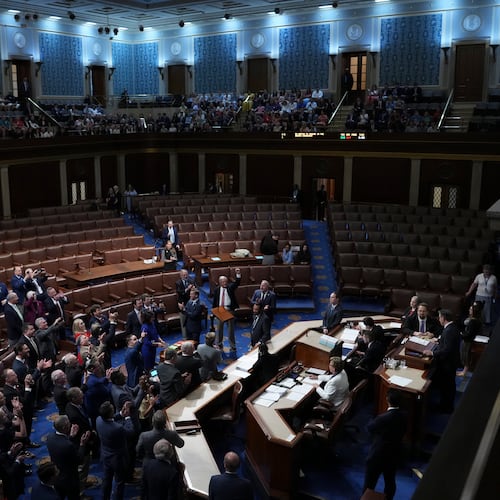Citing environmental concerns and a lack of housing, an increasing number of cities and some West Coast states are reconsidering mandates that all homes, offices and businesses offer a minimum number of parking spots for residents, workers and customers.
Leading the effort is Oregon, which is getting ready to enact permanent statewide land use rules that would allow eight metro areas to eliminate minimum parking requirements for many homes and businesses.
Not far behind is California, where the state Assembly in May passed legislation that could have a similar effect on some minimum parking rules statewide, if it’s passed by the state Senate and signed into law.
Credit: contributed
Credit: contributed
Curtailing parking minimums represents a sweeping shift in American attitudes, particularly in California, a state that glorified and typified car culture – and its accompanying urban sprawl.
But in both Oregon and California, eliminating minimum parking mandates is seen as a way of encouraging compact, climate-friendly communities that address severe housing shortages by making it easier, safer and more affordable to live and work without a car.
The California legislation would prohibit local governments from imposing or enforcing a minimum parking requirement on residential, commercial or other development if the project is within a half-mile walk of public transit.
As in much of the United States, housing shortages in both Oregon and California have led to high home prices, one contributor to the homelessness crisis.
Parking lots aren’t going away any time soon. But planners and developers have long understood that each parking space adds to building costs, and that parking for homes and businesses is overbuilt nearly everywhere.
Estimates vary, but many experts suggest that building individual parking spots starts at $20,000 for those on surface lots and can cost upward of $60,000 for underground garages, according to the Parking Reform Network, which tracks efforts nationwide to change the culture of parking.
The cost of parking gets bundled into the cost of the home or business, or into rent. Parking also takes up space that could be used for housing, particularly in more walkable or bikeable neighborhoods with good access to mass transit.
Doing away with parking minimums is an “easy, really low-hanging fruit to build on,” said Tony Jordan, president of the Parking Reform Network, which is based in Portland. “It’s very hard to implement other known strategies for housing affordability or for climate action or for reducing traffic if you’re mismanaging your parking, or if you’re requiring too much of it.”
In Oregon, addressing minimum parking mandates is part of a larger set of rules issued by the state’s growth management agency this year to slow greenhouse gas emissions and address an affordable housing crisis.
Eight of the largest metro areas in the state, including Portland, must name or establish climate-friendly neighborhoods – typically city and town centers and corridors with high levels of transit. Portland already has rolled back many minimum parking mandates.
The rules also require jurisdictions to permit dense housing and mixed-use development even as they limit car-centric land uses.
Yet, many city and county officials outside of Portland remain skeptical, as do business and trade groups. Many cities called on Oregon’s Department of Land Conservation and Development to hold off on officially enacting the parking and land use rules until they had more assurance of funding to help plan for the changes.
The Oregon Home Builders Association, the League of Oregon Cities and the Association of Oregon Counties along with the Oregon Home Builders Association, Oregon Realtors and the Oregon Restaurant and Lodging Association and the Farm Bureau all logged objections.
The parking mandate discussion can be an entry point to difficult conversations about the effects of car-dominated American life on housing costs and the climate, said Daniel Herriges with Strong Towns, an advocacy organization that studies the effects of post-war North American development patterns.
Oregon’s longstanding state laws addressing urban growth make it easier to enact statewide planning changes, but most shifts in parking policy are happening on a city, not statewide, planning level, Herriges said.
Cities as disparate as Buffalo, San Diego, Hartford and Fayetteville, Ark., have embraced the movement.
Fayetteville, which in 2015 ended minimum parking requirements on all commercial properties, appears to be the first city in the nation to have done so.
The move came after planners noticed that minimum parking requirements made it challenging for investors to redevelop some long-vacant downtown properties, which sat on small lots in the city’s walkable historic district, adjacent to the University of Arkansas.
The city’s zoning codes do have maximum parking: For example, developers who want to exceed them must justify their requests or compensate for the additional heat islands by planting more trees.
And yet there’s tremendous potential in changing parking habits, Herriges said, because it’s the biggest determinant of American urban land use patterns.
Doing away with parking minimums may be the biggest impediment to creating walkable, urban places with more affordable housing options, he said. But it’ll be a long time before it’s the mainstream option.
“Most Americans drive to most places, and that’s going to be true 20 years from now, there’s just no way it isn’t,” Herriges said. “But we desperately need to make the alternatives more available to more people and at a price point that’s available to more people. Parking is the biggest obstacle standing in the way of that.”
Erika Bolstad writes for Stateline, an initiative of The Pew Charitable Trusts.
About the Solutions Journalism Network
This story comes from our partners at the Solutions Journalism Network, a nonprofit organization dedicated to rigorous reporting about social issues.
About the Author
Keep Reading
The Latest
Featured




